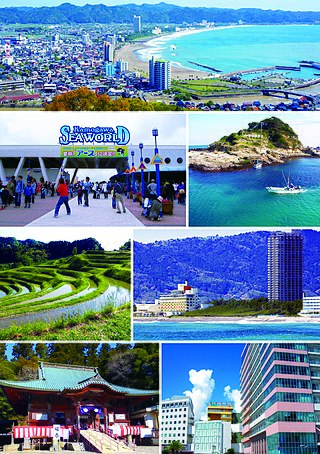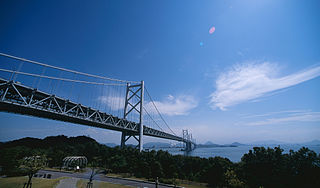
Kamogawa is a city located in Chiba Prefecture, Japan. As of 1 December 2020, the city had an estimated population of 31,722 in 14,558 households and a population density of 170 persons per km². The total area of the city is 191.14 square kilometres (73.80 sq mi).

Kimitsu is a city located in Chiba Prefecture, Japan. As of 30 November 2020, the city had an estimated population of 83,058 in 39,138 households and a population density of 260 persons per km2. The total area of the city is 318.83 km2 (123.10 sq mi).

Sakaide is a city located in Kagawa Prefecture, Japan. As of 1 October 2022, the city had an estimated population of 49,439 in 21347 households and a population density of and a population density of 530 persons per km2. The total area of the city is 92.49 square kilometres (35.71 sq mi).

The Ōtō Line is a railway line in Kyoto that was opened on 5 October 1989 by the Keihan Electric Railway. The Ōtō Line re-established a rail connection between the Keihan Main Line and the Eizan Electric Railway, which had been severed when the Kyoto City streetcars ceased running in 1978. The line is operated as an extension of the Keihan Main Line. All trains continue into the Keihan Main Line and Keihan Nakanoshima Line in Osaka.

The Uchibō Line is a railway line operated by the East Japan Railway Company adjacent to Tokyo Bay, paralleling the western shore of the Bōsō Peninsula. It connects Soga Station in the city of Chiba to Awa-Kamogawa Station in the city of Kamogawa, passing through the municipalities of Chiba, Ichihara, Sodegaura, Kisarazu, Kimitsu, Futtsu, Kyonan, Tateyama, and Minamibōsō. The line is connected at both ends to the Sotobō Line. The name of the Uchibō Line in the Japanese language is formed from two kanji characters. The first, 内, means "inner" and the second, 房 is the first character of the Bōsō. The name of the line thus refers to its location along the inner part of the Bōsō Peninsula in relation to the Tokyo Metropolitan Area, as opposed to the Sotobō Line, "outer Bōsō" which is on the opposite side of the peninsula. South of Kimitsu is single track, and north of Kimitsu is double track.

The Sotobō Line is a railway line in Japan operated by the East Japan Railway Company adjacent to the Pacific Ocean, on the eastern side of the Bōsō Peninsula. It connects Chiba Station in Chiba to Awa-Kamogawa Station in Kamogawa, passing through Ōamishirasato, Mobara, Chōsei, Ichinomiya, Isumi, Onjuku, and Katsuura. The line is connected to the Uchibō Line at both ends. South of Kazusa-Ichinomiya is single track, and north of Kazusa-Ichinomiya is double track.

Awa-Kamogawa Station is a junction passenger railway station in the city of Kamogawa, Chiba Prefecture Japan, operated by the East Japan Railway Company.

The Wakashio (わかしお) is a limited express train service in Japan operated by the East Japan Railway Company. It runs from Tokyo to Kazusa-Ichinomiya and Awa-Kamogawa on the Bōsō Peninsula in Chiba Prefecture.

Kamogawa Station is a junction passenger railway station located in the city of Sakaide, Kagawa Prefecture, Japan. It is operated by JR Shikoku and has the station number "Y06".

Awa-Amatsu Station is a passenger railway station in the city of Kamogawa, Chiba Prefecture, Japan, operated by East Japan Railway Company.

Kazusa-Kameyama Station is a passenger railway station in the city of Kimitsu, Chiba Prefecture, Japan, operated by the East Japan Railway Company.

Yukari Kinga is a Japanese football player. She is currently playing as a defender for Sanfrecce Hiroshima Regina in the WE League. She previously played for the Japan women's national football team, winning a World Cup and an Olympic silver medal before her international retirement in 2016.

Lagrange: The Flower of Rin-ne is a Japanese anime television series produced by Xebec and Production I.G and directed by Tatsuo Sato and Toshimasa Suzuki, written by Shotaro Suga, original character design by Haruyuki Morisawa and music by Saeko Suzuki & TOMISIRO. Set in Kamogawa, the series revolves around Madoka Kyouno, Fin E Ld Si Laffinty (Lan) and Muginami, who all come from different worlds and attend the Kamogawa Girls' High School. While they form the Jersey Club to fulfill tasks for other school clubs, they are also destined to pilot strange robotic aircraft known as Vox Units, supported by a military organization named Novumundus stationed at an offshore base called Pharos. Their ultimate mission is to cease the intergalactic war between neighboring planets called Le Garite and De Metrio, in an attempt to restore the friendship between the planets' respective leaders named Dizelmine and Villagulio.

Mikio Mizuta was a Japanese jurist, educator and politician. He served as finance minister of Japan three times and was the founder of Josai University.
Chinatsu Kira is a Japanese football player. She plays for Japanese Nadeshiko League club Orca Kamogawa. She played for the Japanese national team.
Orca Kamogawa FC is a women's football club playing in Japan's football league, the Nadeshiko League Division 1. Its hometown is the city of Kamogawa.
Chiaki Minamiyama is a Japanese football player. She played for Japan national team.
Ayako Kitamoto is a former Japanese football player and manager. She played for Japan national team.

Kamogawa Sea World is a large scale comprehensive marine leisure center/museum equivalent facility located between the Tojo coast and the national highway No. 128 in Kamogawa city, Chiba Prefecture, Japan. It is not affiliated with SeaWorld in any way and is operated by Granvista Hotels & Resorts Co., Ltd. it is a public aquarium and is also a member of Japanese Association of Zoos and Aquariums (JAZA). In 2021, the park celebrated the 50th anniversary of its opening.
The 2022 Empress's Cup is the 44th season of the Japanese women's football main cup competition. All the non-relegated teams from the 1st and 2nd division of the 2021 Nadeshiko League automatically qualified to the first and second round, while all 11 teams from the 2022–23 WE League earned an automatic entry to the Round of 16.
















